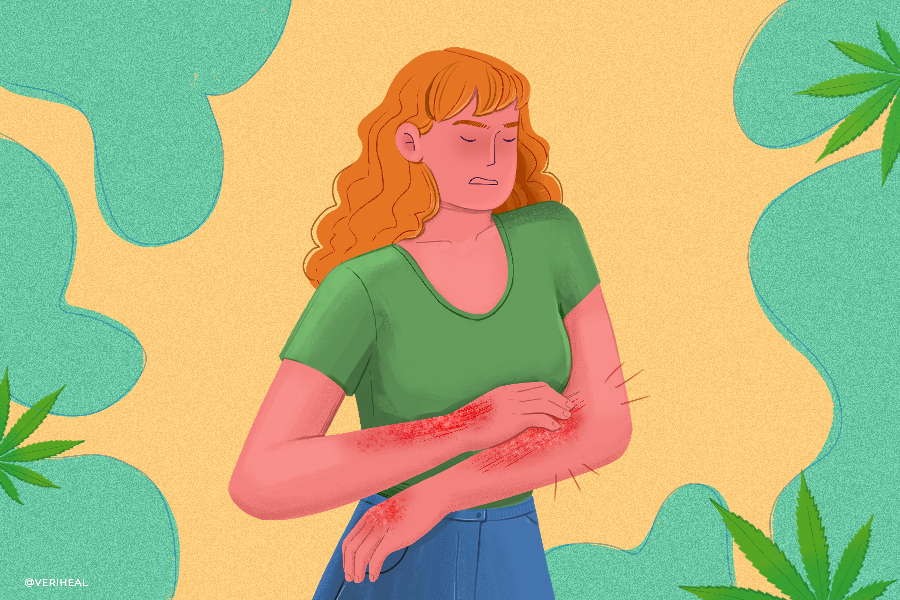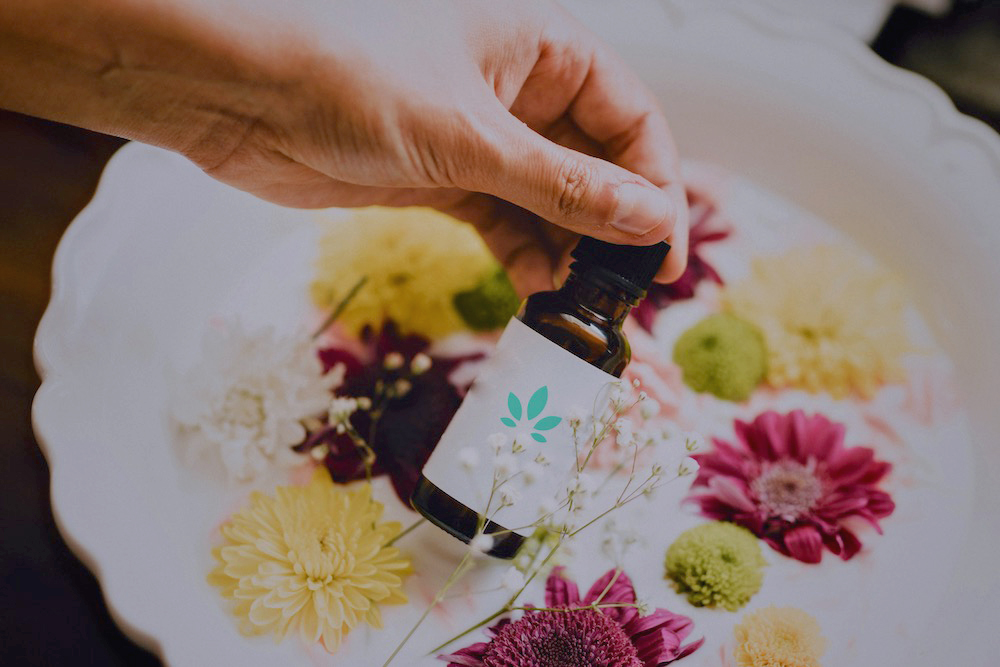Does Medical Marijuana Help Eczema?

- Eczema, Itching and Medical Cannabis
- Relieving Eczema with Cannabis
- Dermatologic Use of Medical Cannabis: Important Notes
- Types of Eczema
Itchy, inflamed, and irritated skin is caused by much more than dryness and for many patients who suffer from eczema, it can be a daily struggle. Fortunately, current research suggests that medical cannabis and its cannabinoids, including cannabidiol (CBD) and Δ9-tetrahydrocannabinol (THC), might be a new and improved way to target treating skin conditions. Preliminary research suggests that cannabis may help relieve skin issues such as eczema, skin cancer, acne, psoriasis, and pruritus (itchy skin) (4).
Cannabis interacts through a variety of receptors in the body. The most well-known pathway is through the endocannabinoid system (ECS). This recently discovered bodily system is made up of fat-based neurotransmitters which can be increased or decreased when cannabinoids meet cannabinoid receptors CB1 and CB2, and other targets. The ECS helps the body with several processes including maintaining proper body temperature, pain perception, and controlling inflammation in our body, including in the skin.
Current research has found that both CB1 and CB2 are found in keratinocytes (the primary skin cell) in the top layer of the skin as well as skin nerve fibers, skin cells, melanocytes (produce melanin or pigment), sweat glands, and hair follicles (3)(9). Additionally, anandamide (AEA) and 2-arachidonoylglycerol (2-AG) are major endocannabinoids found in keratinocytes and fibroblast cells in the skin.
In addition to interacting with the ECS, medical cannabis activates transient receptor potential (TRP) receptors in a variety of skin cells that are responsible for the formation and maintenance of the skin barrier, as well as immunological and inflammation in the skin (3). The cannabinoids found in cannabis also interact with peroxisome proliferator-activated receptors (PPAR) that are responsible for regulating the expression of genes. This is important because many eczema patients have a gene deficiency that leads to the breakdown and inflammation of the barrier of the skin. Unfortunately, this breakdown can lead to dry skin, skin allergies, itching, cracking, bleeding, and infections in the skin (19).
Eczema, Itching and Medical Cannabis
Researchers believe that cannabis offers great potential in treating the most common form of eczema called atopic dermatitis (AD). Medical marijuana is known for its strong anti-inflammatory properties all over the body, including in the skin. They believe that it has something to do with a combination of CB2 receptors in keratinocytes and TRP receptors. TRP receptors are believed to function as ‘ionotropic cannabinoid receptors’ (4). Ionotropic cannabinoids receptors are thought to control nociception, or pain in the nerves of the skin as well as exert antihyperalgesic and inflammatory reduction effects (2). Researchers attribute such receptors to cannabis’ ability to relieve the itching involved in eczema (6)(4).
A 2007 study tested the use of a cream containing N-palmitoylethanolamine (PEA), a fatty endocannabinoid in 2456 patients with AD. This study showed that itching, scaling, dryness, and redness were greatly reduced in 58.6% of all ages of patients in the study, and 56% of patients discontinued using corticosteroids by the end of the study (27). Corticosteroids are considered a standard form of eczema care along with over-the-counter lotions. Many of these patients reported quality of life improvements as well as improvements in sleep. Though PEA is an endocannabinoid not found in cannabis, the same receptors can be activated by cannabis through the ECS and warrant further research on endocannabinoids and eczema.
Relieving Eczema with Cannabis
Many patients who use cannabis for their skin prefer the use of topical products that contain both CBD and THC. THC’s activation of CB1 receptors is typically known for its ability to reduce pain, which can be associated with eczema. On the other hand, CB2 receptors have been nicknamed the “immunocannabinoid” system receptors for their ability to aid immune function and decrease inflammation in various areas of the body in addition to the skin (3). These products are ideal for eczema because they can directly target cannabinoid receptors in addition to TRP and PPAR receptors that live in the skin. Because there are so many receptors locally on the skin, it utilizes the cannabinoids efficiently which is why people don’t have psychoactive effects from topical products and they don’t typically show up during blood tests unless used on a frequent basis.
Please check out our CBD guide to find out how to identify safe CBD products.
Dermatologic Use of Medical Cannabis: Important Notes
It is important to note that when it comes to the dermatologic use of the cannabis plant, there is still a risk of side effects involved. Additionally, cannabinoids bind to multiple receptors in the body at once, and varying doses may have different effects on the receptors, which may give you different outcomes than what you desire (4). Since the research involving skin conditions and cannabis is so new, the way your body will respond to cannabinoids, dermatologists can not be reliably predicted the results at this time. While active cannabinoids are not appreciably absorbed into the rest of the body past the skin, their metabolites can accumulate over time and potentially complicate drug testing results. The long-term effects of cannabinoids and their metabolites, even applied topically, are not fully known at this time but so far are generally safe.
Types of Eczema
There are seven main types of eczema, which is actually a group of skin conditions as opposed to only one as many people think. These conditions cause the skin to become itchy, inflamed and have a hive-like appearance (5). Often patients with eczema have scaly patches of skin from where it occurs. The main types of eczema include:
Atopic Dermatitis (AD)
Considered the most common type of eczema, it is caused by the immune system becoming disordered and overactive which triggers inflammation (19). The inflammation damages the barrier to the skin, leaving it dry, itchy, rashed, and cracked. The skin may ooze or bleed when eczema occurs. Patients who have asthma or hay fever are more likely to develop AD due to underlying genetic similarities.
Atopic dermatitis usually starts within the first 6 months of a baby’s life. It may improve at times or get worse over time. Some patients can outgrow it, while others are not so lucky and have it into adulthood (19). According to the National Eczema Foundation, research shows that there is a mutation in the gene that is responsible for creating a protein called filaggrin. Filaggrin helps the top layer of our skin maintain a healthy and protective layer. Without this protective barrier, the skin easily loses moisture and allows bacteria and viruses to get in.
Contact Dermatitis
Contact dermatitis occurs when the skin becomes irritated and inflamed after encountering something that basically triggers a skin allergic reaction. Unlike AD, it is not genetic in families and isn’t linked to hay fever or asthma (20). It consists of two subtypes that include (20):
- Allergic contact dermatitis – which is a delayed allergic reaction to something that has touched the skin. It usually shows up a day or two after the skin encounters the allergen. A common example is a skin reaction after exposure to poison ivy plants.
- Irritant contact dermatitis – Accounting for most cases of contact dermatitis, it occurs when the skin has been damaged by solvents, detergents, soaps, or nickel-containing items. It can also be caused by too much handwashing with soap and hot water.
Dyshidrotic Eczema
Also known as pompholyx which means “bubble”, dyshidrotic dermatitis causes intensely itchy and red blisters on the palms of hands, soles of feet, and the edges of the fingers and toes (21). Doctors don’t exactly know what causes it, but it is more common in patients who have other forms of eczema and it tends to be genetic. Interestingly, it is more common in women than men. It can be linked to seasonal allergies, humidity, stress, and metals such as nickel.
Neurodermatitis
This type of eczema is usually confined to one or two spots on the skin and affects about 12% of the population (22). It causes patches of itchy skin, which because the patient scratches more, the skin gets thick and leather-like. The continued scratching can cause the skin to bleed, and lead to an infection or scarring over time. It is most common in women between 30 and 50 years old that have AD or contact dermatitis. It can be linked to anxiety, stress, and other emotional issues that contribute to the itch-scratch cycle.
Nummular Eczema
Also known as nummular dermatitis or discoid eczema, this type of eczema is known for scattered, circular, and often oozy and itchy patches of skin (23). Nummular eczema can be easily confused with psoriasis based on appearance and is more common in males than females. It can be triggered by very dry or sensitive skin, as well as trauma to the skin from bug bites, scrapes, or chemical burns.
Seborrheic Dermatitis
This chronic form of eczema is typically on the scalp, upper back, and nose where there are large numbers of oil-producing glands on the skin. It is most common in adults 30-60 and it can come and go over years (24). It is called cradle cap in babies and can cause an itchy, flaky and greasy scaling.
It is caused by an inflammatory reaction to excess Malassezia yeast that normally lives on the skin. It can also be linked to the following medical conditions: psoriasis, HIV, acne, Parkinson’s disease, epilepsy, alcoholism, depression, eating disorders, and heart attack or stroke recovery (24). Common triggers include stress, hormonal changes, illness, harsh chemicals, cold/dry weather, and certain medications.
Stasis Dermatitis
Also known as gravitational dermatitis, venous eczema, and venous stasis dermatitis, it is caused when there is poor circulation in the lower legs (25). Poor circulation, also known as venous insufficiency, happens when the valves in your leg veins have weakened and are not strong enough to fully push blood back to your heart. When this occurs, the valves leak with normal aging, but can also be a sign of a serious medical condition such as heart disease or kidney disease. It causes swelling in the feet and lower legs as well as redness in light skin tones or brown, purple, grey, or ashen patches of skin in patients who have darker skin tones in addition to itchy, scaly, and aching skin. Poor circulation in these situations can also lead to skin ulcers.
Note: Veriheal does not intend to give this as professional medical advice. Do not attempt to self-diagnose or prescribe treatment based on the information provided on this page. Always consult a physician before making any decision on the treatment of a medical condition.
1. Adusumilli, N. C., Hazuka, E. L., & Friedman, A. J. (2021). Nanotechnology to deliver cannabinoids in dermatology. Precision Nanomedicine. https://www.researchgate.net/publication/352200710_Nanotechnology_to_deliver_cannabinoids_in_dermatology
2. Akopian, A. N., Ruparel, N. B., Jeske, N. A., Patwardhan, A., & Hargreaves, K. M. (2009). Role of ionotropic cannabinoid receptors in peripheral antinociception and antihyperalgesia. Trends in pharmacological sciences, 30(2), 79–84. https://www.ncbi.nlm.nih.gov/pmc/articles/PMC2863326/
3. Baswan, S. M., Klosner, A. E., Glynn, K., Rajgopal, A., Malik, K., Yim, S., & Stern, N. (2020). Therapeutic Potential of Cannabidiol (CBD) for Skin Health and Disorders. Clinical, cosmetic and investigational dermatology, 13, 927–942. https://www.ncbi.nlm.nih.gov/pmc/articles/PMC7736837/
4. Eagleston, L. R., Kalani, N. K., Patel, R. R., Flaten, H. K., Dunnick, C. A., & Dellavalle, R. P. (2018). Cannabinoids in dermatology: A scoping review. Dermatology Online Journal, 24(6). https://escholarship.org/uc/item/7pn8c0sb
5. Eczema symptoms & causes. National Eczema Association. (2020, August 27). Retrieved November 11, 2021, from https://nationaleczema.org/eczema/
6. Feramisco, J. D., Berger, T. G., & Steinhoff, M. (2010). Innovative management of pruritus. Dermatologic clinics, 28(3), 467–478. https://pubmed.ncbi.nlm.nih.gov/20510757/
7. Gupta, A. K., & Talukder, M. (2021). Cannabinoids for skin diseases and hair regrowth. Journal of Cosmetic Dermatology, 20(9), 2703–2711. https://onlinelibrary.wiley.com/doi/10.1111/jocd.14352
8. Hashim, P. W., Cohen, J. L., Pompei, D. T., & Goldenberg, G. (2017). Topical cannabinoids in dermatology. Cutis, 100(1), 50–52. https://cdn.mdedge.com/files/s3fs-public/Document/July-2017/CT100001050.PDF
9. Kupczyk, P., Reich, A., & Szepietowski, J. C. (2009). Cannabinoid system in the skin – a possible target for future therapies in dermatology. Experimental dermatology, 18(8), 669–679. https://onlinelibrary.wiley.com/doi/10.1111/j.1600-0625.2009.00923.x
10. Liszewski, W., & Farah, R. S. (2017). Response to: “the role of cannabinoids in dermatology.” Journal of the American Academy of Dermatology, 77(3). https://www.jaad.org/article/S0190-9622(17)31770-X/fulltext
11. Liszewski, W., Stoff, B. K., & Farah, R. S. (2018). The ethics of medical marijuana in dermatology. Journal of the American Academy of Dermatology, 78(3), 634–636. https://www.jaad.org/article/S0190-9622(17)32266-1/fulltext
12. Nickles, M. A., & Lio, P. A. (2020). Cannabinoids in dermatology: Hope or hype? Cannabis and Cannabinoid Research, 5(4), 279–282. https://www.liebertpub.com/doi/full/10.1089/can.2019.0097
13. Río, C. D., Millán, E., García, V., Appendino, G., DeMesa, J., & Muñoz, E. (2018). The endocannabinoid system of the skin. A potential approach for the treatment of skin disorders. Biochemical pharmacology, 157, 122–133. https://static1.squarespace.com/static/5dab51c52920995e635d4295/t/5e146bc591a90d6253893f69/1578396623219/delRio2018BiochemPharmacol.pdf
14. Roh YS, Sutaria N, Biles NF, Kwatra SG. Treatment of Chronic Pruritus With Medical Marijuana. JAMA Dermatol. 2021;157(7):879–880. https://jamanetwork.com/journals/jamadermatology/article-abstract/2778442
15. Scheau, C., Badarau, I. A., Mihai, L.-G., Scheau, A.-E., Costache, D. O., Constantin, C., Calina, D., Caruntu, C., Costache, R. S., & Caruntu, A. (2020). Cannabinoids in the pathophysiology of skin inflammation. Molecules, 25(3), 652. https://www.mdpi.com/1420-3049/25/3/652
16. Sheriff, T., Lin, M. J., Dubin, D., & Khorasani, H. (2019). The potential role of cannabinoids in dermatology. Journal of Dermatological Treatment, 31(8), 839–845. https://pubmed.ncbi.nlm.nih.gov/31599175/#:~:text=Cannabinoids%20have%20demonstrated%20anti%2Dinflammatory,promising%20alternative%20to%20traditional%20treatments.
17. Sheriff, T., Lin, M. J., Dubin, D., & Khorasani, H. (2020). The potential role of cannabinoids in dermatology. The Journal of dermatological treatment, 31(8), 839–845. https://pubmed.ncbi.nlm.nih.gov/31599175/
18. Shalaby, M., Yardley, H., & Lio, P. A. (2018, January). Stirring the pot: Cannabinoids and atopic dermatitis. Practical Dermatology. Retrieved November 6, 2021, from https://practicaldermatology.com/articles/2018-jan/stirring-the-pot-cannabinoids-and-atopic-dermatitis
19. What is atopic dermatitis and how can I tell if I have it? National Eczema Association. (2021, January 15). Retrieved November 11, 2021, from https://nationaleczema.org/eczema/types-of-eczema/atopic-dermatitis/
20. What is contact dermatitis and how is it treated? National Eczema Association. (2020, December 4). Retrieved November 11, 2021, from https://nationaleczema.org/eczema/types-of-eczema/contact-dermatitis/
21. What is dyshidrotic eczema and how do you know if you have it? National Eczema Association. (2021, November 4). Retrieved November 11, 2021, from https://nationaleczema.org/eczema/types-of-eczema/dyshidrotic-eczema/
22. What is neurodermatitis and how do you know if you have it? National Eczema Association. (2020, December 18). Retrieved November 11, 2021, from https://nationaleczema.org/eczema/types-of-eczema/neurodermatitis/
23. What is nummular eczema and what should you do if you have it? National Eczema Association. (2021, January 15). Retrieved November 11, 2021, from https://nationaleczema.org/eczema/types-of-eczema/nummular-eczema/
24. What is seborrheic dermatitis and how do you know if you have it? National Eczema Association. (2021, January 15). Retrieved November 11, 2021, from https://nationaleczema.org/eczema/types-of-eczema/seborrheic-dermatitis/
25. What is stasis dermatitis and how do you know if you have it? National Eczema Association. (2020, September 23). Retrieved November 11, 2021, from https://nationaleczema.org/eczema/types-of-eczema/stasis-dermatitis/
26. Zhang, H., Yang, Y., Cui, J., & Zhang, Y. (2012). Gaining a comprehensive understanding of pruritus. Indian journal of dermatology, venereology and leprology, 78(5), 532–544. https://ijdvl.com/gaining-a-comprehensive-understanding-of-pruritus/
27. Eberlein, B., Eicke, C., Reinhardt, H. W., & Ring, J. (2008). Adjuvant treatment of atopic eczema: assessment of an emollient containing N-palmitoylethanolamine (ATOPA study). Journal of the European Academy of Dermatology and Venereology : JEADV, 22(1), 73–82. https://pubmed.ncbi.nlm.nih.gov/18181976/








